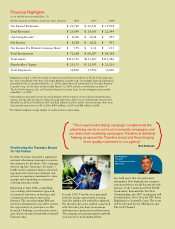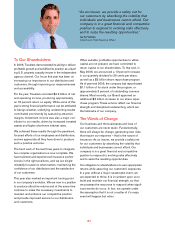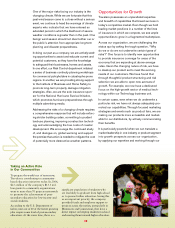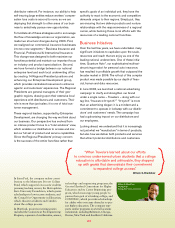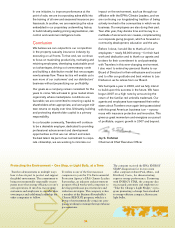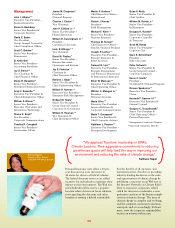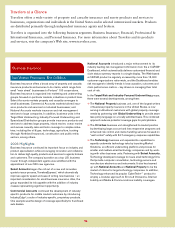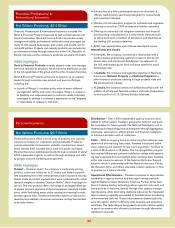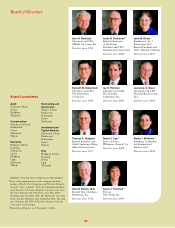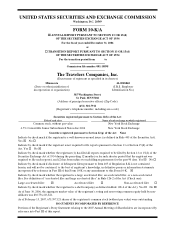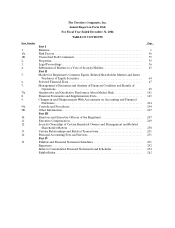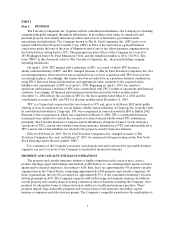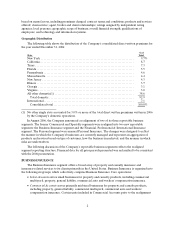Travelers 2006 Annual Report Download - page 4
Download and view the complete annual report
Please find page 4 of the 2006 Travelers annual report below. You can navigate through the pages in the report by either clicking on the pages listed below, or by using the keyword search tool below to find specific information within the annual report.
02
One of the major risks facing our industry is the
changing climate. While we are fortunate that this
past wind season came to a close without a serious
event, we continue to heed the warnings of climate
experts who indicate that we have entered an
extended period in which the likelihood of severe
weather conditions is greater than in the past. One
benign wind season should not divert either our or
the public’s attention from appropriate long-term
planning and disaster preparedness.
In doing our part as a company, we are actively seek-
ing opportunities to assist and educate current and
potential customers, so they have the knowledge
to safeguard their businesses, homes and assets.
In one effort, our Risk Control department initiated
a series of business continuity planning workshops
for commercial policyholders in catastrophe-prone
regions. In another, we are providing strong support
to the Institute of Business and Home Safety to
promote long-term property damage mitigation
strategies. Also, we are the sole insurance spon-
sor for the National Hurricane Survival Initiative,
which promotes hurricane preparedness through
multiple advertising media.
Addressing the risks of a changing climate requires
a comprehensive response that will include enforc-
ing stricter building codes, committing to prudent
land-use planning, improving construction technol-
ogy and acknowledging the true costs of coastal
development. We encourage the continued study
of, and dialogue on, global warming and support
the premise that action is needed to mitigate the cost
of potentially more destructive weather patterns.
Opportunities for Growth
Travelers possesses an unparalleled expertise
and breadth of capabilities that breed success in
today’s competitive market. Even though we hold
leading market positions in a number of the lines
of insurance in which we compete, we see ample
opportunities to grow in a fragmented marketplace.
Across our organization, we are challenging the
status quo by asking the tough question, “Why
do we or do we not underwrite certain types of
risks?” One focus is to identify new opportunities
to provide insurance coverage for areas of the
economy that are expanding at above-average
rates. Given the changing nature of risk, we have
to develop our product set to meet the evolving
needs of our customers. We have found that
through thoughtful product structuring and risk
selection we are able to open new avenues of
growth. For example, we now have a dedicated
focus on the high-growth sector of medical tech-
nology within our Technology business unit.
In certain cases, even when we do underwrite a
particular risk, we have not always adequately pro-
moted our capabilities. Through focused marketing
strategies and events such as product fairs, we are
making our products more accessible and market-
able for our distributors, by actively communicating
their benefits.
It is particularly powerful when we can translate a
market leadership in one industry or product segment
into growth prospects across our organization,
by applying our expertise and working through our
Taking an Active Role
in Our Communities
To prepare the workforce of tomorrow,
Travelers is contributing to community-
based education initiatives today. In 2006,
$2.3 million of the company’s $15.5 mil-
lion grants to community organizations
went to more than 70 projects nationwide
to promote the achievement of post-
secondary education for low-income and
at-risk students.
According to the U.S. Department of
Labor, nine out of 10 of the fastest growing
jobs require some level of post-secondary
education. At the same time, there is a
significant population of students who
are less likely to graduate from high school
or to pursue further education. Seeing this
as an important priority, the company
provided funds and employee support to
projects across the nation, particularly in
Minnesota and Connecticut, that have a
direct impact on keeping students in school
and moving them towards higher education.


